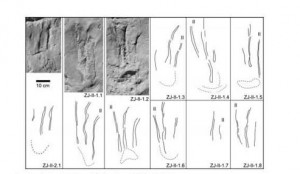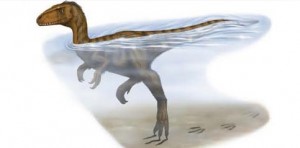Trackways Preserve Evidence of a Theropod Dinosaur Going for a Swim
A team of scientists from China supported by colleagues from the University of Alberta (Canada), have published a report on a series of dinosaur tracks, one of which indicates that a small theropod dinosaur swam across a river, a rare incidence of dinosaur swimming behaviour preserved as a trace fossil. The fossilised track is just one of a series of dinosaur trackways preserved in the Lower Cretaceous strata of the Feitianshan Formation of Sichuan Province (China).
Swimming Theropod Dinosaur
The area has been extensively quarried and unfortunately, many of the footprints have been destroyed but the international team of ichnologists (scientists who specialise in studying footprints and tracks), have been able to identify a series of ornithopod tracks plus the large footprints of a titanosaur (long-necked dinosaur).
It seems that the titanosaur crossed the river at around the same time as the small, meat-eating dinosaur. The water depth at the time has been estimated to have been about ninety centimetres deep. For the theropod, that meant a swim, but for the much larger titanosaur, it was able to wade across.
Swimming Trackway
The swimming trackway has been assigned to the ichnogenus Characichnos. An ichnogenus is a scientific name given to an organism that is only known from trace fossils such as footprints. Interestingly, similar sized, tridactyl (three-toed) prints have been found preserved on the sandstone substrate that indicate a small theropod dinosaur also walked across the site. The swimming and walking tracks being found in close proximity has been interpreted as the water depth fluctuating over a short time period. Additionally, the ornithopod tracks are made up of a series of footprints all moving in the same direction and parallel to each other. This suggests that a herd or a family group of these plant-eating dinosaurs made their way over the sand.
Evidence of a Swimming Theropod Dinosaur
Picture credit: Chinese Science Bulletin
The picture above shows photographs of the tridactyl claw marks with line drawings showing how these trace fossils have been interpreted by the scientific team.
“Chinese Science Bulletin”
The paper detailing the work on the dinosaur footprints has been published in the academic journal the “Chinese Science Bulletin”. Unlike the footprints left by the theropod when it walked on land, the swimming tracks just show three scratch marks and the marks left by each foot as it touched the bottom are not equidistant from each other. This suggests that the dinosaur, estimated to be around two metres in length was swimming, occasionally touching the sandy bottom of the body of water that it was crossing, leaving claw marks where its talons dug into the sand. Such trackways are very rare, although palaeontologists in Spain have studied a similar set of swimming tracks made by a much larger theropod dinosaur.
To read about the Spanish dinosaur tracks: Dinosaurs Going for a Swim.
Fifteen Metres Long
University of Alberta palaeontologist Scott Persons commented that the swimming trackway was approximately fifteen metres in length, analysis of the claw marks suggested that this little dinosaur was a strong swimmer, using a “doggy paddle” type stroke to propel itself through the water. The PhD student stated that these trace fossils suggested that this type of dinosaur was a strong swimmer capable of swimming considerable distances, although the water would have been a dangerous place to be as there was the threat of attack from predators such as prehistoric crocodiles.
An Illustration of the Ichnogenus Characichnos
Illustration credit: Nathan E. Rogers
He stated:
“The dinosaur’s claw marks show it was swimming along in this river and just its tiptoes were touching bottom.”
Scott went on to comment that although there was some amazing fossil discoveries being made in China at the moment, Alberta with its extensive exposures of Upper Cretaceous strata such as the Dinosaur Provincial Park Formation, was a great place for a vertebrate palaeontologist to be. He made the point that there was no need to travel all the way to China to study Cretaceous dinosaurs when within a couple of hours drive of his home he could be right in prime dinosaur bone finding territory.
Dinosaur Models and Figures
Everything Dinosaur stocks a huge range of dinosaur and prehistoric animal models including titanosaurs and small theropod dinosaurs: Everything Dinosaur Models and Figures.
The Chinese research team hope that with the co-operation of the quarry owners they will be able to study more of the tracks and perhaps be able to remove some of them so that they can be put on display at a local natural history museum.







Leave A Comment